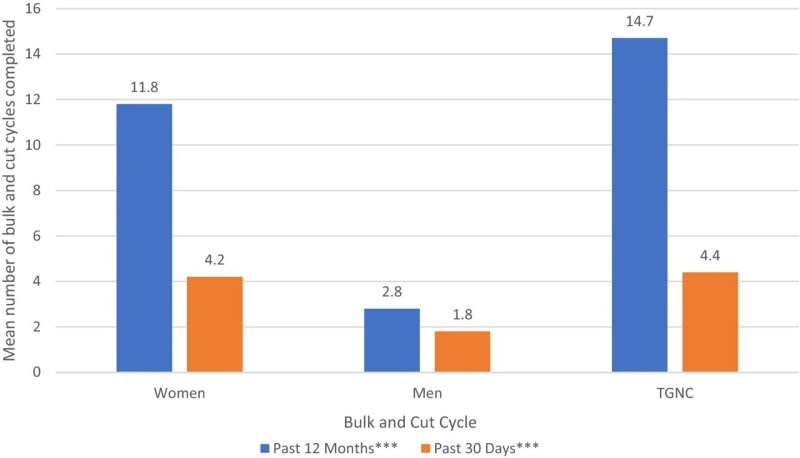'Bulk and cut' dieting linked to symptoms of eating disorders and muscle dysmorphia

Studies on anorexia, bulimia and obesity have found that nearly half of men, and one in five women, transgender and gender non-conforming participants, engaged in a "bulk and cut" cycle in the past 12 months.
"Bulking and cutting"—a dietary technique characterized by alternating between periods of consuming surplus calories (bulking) and restricting calorie consumption (cutting) in order to optimize the growth of lean muscle mass and reduce body fat—is a practice that aligns with current body ideals. It is especially prevalent among adolescents and young adults, particularly those within the fitness community and those who are striving to achieve a more muscular and toned body.
Analyzing data from over 2,700 Canadian adolescents and young adults, the researchers found that engagement in bulking and cutting was connected with a greater desire to become more muscular, among all groups of participants, underscoring the link between this dietary method and desires to change one's body.
"Bulking and cutting is a common practice within the fitness community, and is popularized by social media," says lead author Kyle T. Ganson, Ph.D., MSW, assistant professor at the University of Toronto's Factor-Inwentash Faculty of Social Work. "Given body ideals that focus on bulk muscularity and leanness in boys and men, it is not surprising that this dietary method was highly common in our sample, but it should also be noted that girls, women, transgender, and gender non-confirming participants, also face unique pressures to adhere to specific body types. For girls and women, this ideal is transitioning away from the thin ideal to a toned and fit ideal."
Few studies, however, have explored and characterized engagement in bulk and cut cycles, or whether this dietary method is linked with the drive for muscularity and eating disorder and muscle dysmorphia psychopathology.
"Our findings also showed that engagement in bulking and cutting was associated with symptoms of eating disorders, as well as muscle dysmorphia, which is characterized as the pathological pursuit of muscularity, for men and women in the study," says Ganson. "These findings are particularly salient given the documented increased prevalence of eating disorders and related behaviors during the COVID-19 pandemic."
The study illuminates the importance of greater awareness of this unique dietary method, which may go unnoticed by health care and public health professionals.
"It is important that health care professionals screen for a vast array of dietary practices that may be harmful for young people, not just clinical eating disorder behaviors, like food restriction," Ganson says. "We need to continue to research these forms of muscularity-oriented behaviors to better understand them and implement effective strategies to protect the health and well-being of Canadian young people."
The research was published in Eating and Weight Disorders—Studies on Anorexia, Bulimia and Obesity.
More information: Kyle T. Ganson et al, "Bulking and cutting" among a national sample of Canadian adolescents and young adults, Eating and Weight Disorders—Studies on Anorexia, Bulimia and Obesity (2022). DOI: 10.1007/s40519-022-01470-y



















